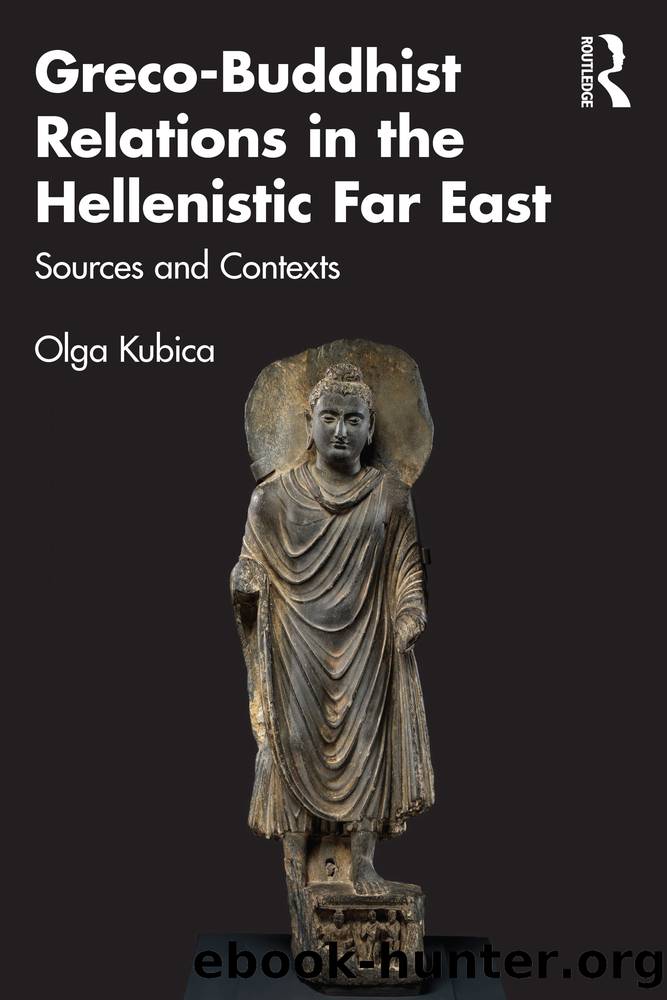Greco-Buddhist Relations in the Hellenistic Far East by Olga Kubica;

Author:Olga Kubica;
Language: eng
Format: epub
Publisher: Taylor & Francis (Unlimited)
Published: 2023-02-09T00:00:00+00:00
The inscription of the son of Aristonax30
Then from Ai Khanoum, which is located in the north, we move south towards Kandahar, an area where the Indian influences are pronounced. But we find a purely Greek inscription here, the inscription of the son of Aristonax (Figure 3.3), which antedates the times of the Greco-Bactrian kingdom, but it serves as a context for the remaining two inscriptions discussed, because it may point to a Greek cultural continuity in the areas of Northwest India regardless of the reign and dominant religion. It is a Greek epigram on a statue base, found by the British Institute of Afghan Studies at Shar-Ä«-Kuna (later Old Kandahar) in 1978, and it is dated to the time between 300 BC and 275/250 BC, most probably around 275 BC. So it is possible that this statue was erected a little earlier than the bilingual edict of AÅoka, which was carved on a rock merely a few hundred metres from where our inscription was found.
FIGURE 3.3 The inscription of the son of Aristonax. The inscription was heavily damaged because the stone was re-used as a threshold of a Hellenistic house. Nevertheless, the text could be identified âas consisting of at least two elegiac couplets, and as forming a metrical dedication of a statue-group of some sortâ (Fraser 1979: 9).31
The statue was erected in the sacred precinct (ÏέμενοÏ). Oikonomides, in his article âThe ÏÎÎ¼ÎµÎ½Î¿Ï of Alexander the Great at Alexandria in Arachosia (Old Kandahar)â (1984), argued that this Ïá½³Î¼ÎµÎ½Î¿Ï was used for the cult of Alexander the Great, who was the founder of Alexandria in Arachosia. In his theory, Oikonomides supported the identification by Wheeler (1968: 65) of the site in Old Kandahar with Alexandria in Arachosia founded by Alexander. Although the identification of Alexandria in Arachosia is generally acknowledged, there is no clear evidence that this Ïá½³Î¼ÎµÎ½Î¿Ï was affiliated with the cult of Alexander.
The inscription is a dedication of a statue by the son of Aristonax, whose name is unknown. The word ÎÎΡÎΣ may be a part of this name, but more probably it is a genitive of a noun θήÏ, denoting a wild animal. ÎÎΡÎΣΠcan therefore be reconstructed as θηÏá½¸Ï á¼[γαλμα], sculpture of a wild animal. So, perhaps the statue commemorated the rescue from a wild beast and represented both, the animal and the saviour of the son of Aristonax (ÏÏÏá¿ÏÎ¿Ï á¼Î¼Î¿á¿¦). The name of the son of Aristonax would therefore need to be reconstructed from ÎÎÎÎ, which is not possible due to a large number of Greek names starting with this stem. Oikonomides, on the contrary, reconstructed the name of the dedicator from the third line, which, according to him, should be read: καὶ ÏÏÏá¿ÏÎ¿Ï á¼Î¼Î¿á¿¦ Ïâ [οá½Î½Î¿Î¼Î± á¼ÏÏνâ¦] etc. and thus the son of Aristonax would be a namesake of his rescuer, allegedly Alexander. The end of the second verse (á¼ÏÏοá¿Ï, citizens or fellow citizens) is, according to Rougemont (2012b: 166), the proof of the existence on the site of Old Kandahar of an important Greek community, probably a real city with its sanctuaries, that of the high Hellenistic period.
Download
This site does not store any files on its server. We only index and link to content provided by other sites. Please contact the content providers to delete copyright contents if any and email us, we'll remove relevant links or contents immediately.
The European History Highway: A Guide to Internet Resources by Dennis A. Trinkle Scott A. Merriman(494)
The Seven Wonders of the Ancient World by Michael Denis Higgins(477)
European Security in a Global Context by Thierry Tardy(470)
European Security without the Soviet Union by Stuart Croft Phil Williams(469)
The Routledge companion to Christian ethics by D. Stephen Long Rebekah L. Miles(458)
Hudud Al-'Alam 'The Regions of the World' - a Persian Geography 372 A.H. (982 AD) by V. V. Minorsky & C. E. Bosworth(399)
Gorbachev And His Generals by William C. Green(391)
Get Real with Storytime by Julie Dietzel-Glair & Marianne Crandall Follis(390)
Tibetan Studies in Comparative Perspective by Chih-yu Shih Yu-Wen Chen(385)
Governance, Growth and Global Leadership by Espen Moe(381)
Hyperculture by Byung-Chul Han(378)
CliffsNotes on Fitzgerald's The Great Gatsby by Kate Maurer(360)
The Oxford History of the World by Fernández-Armesto Felipe;(354)
How Languages Are Learned 5th Edition by Patsy M Lightbown;Nina Spada; & Nina Spada(353)
The Egyptian Economy, 1952-2000 by Khalid Ikram(352)
Oral Poetry and Narratives from Central Arabia: The Poetry of Ad-Dindan : A Bedouin Bard in Southern Najd (Studies in Arabic Literature, Vol 17) (English and Arabic Edition) by P. M. Kupershoek P. Marcel Kurpershoek(343)
The Oxford Handbook of the Incas by Sonia Alconini(333)
Europe Contested by Harold James(319)
The Hutchinson Dictionary of Ancient and Medieval Warfare by Peter Connolly John Gillingham John Lazenby(305)
